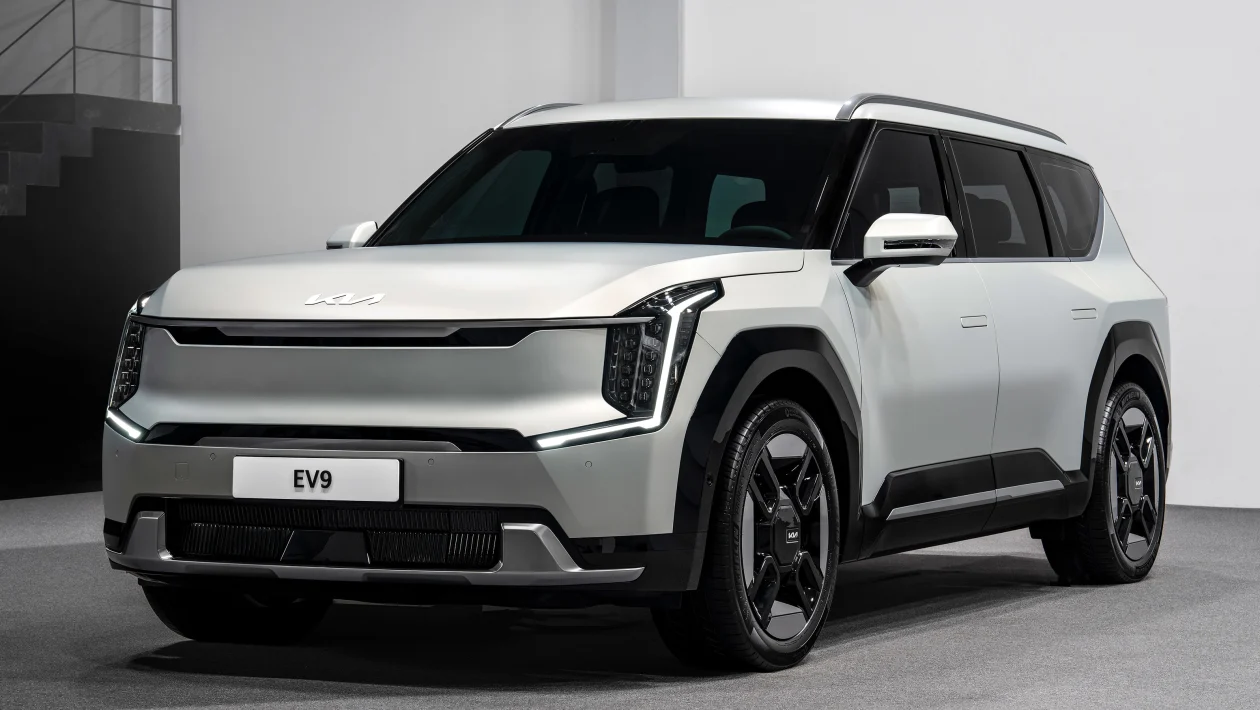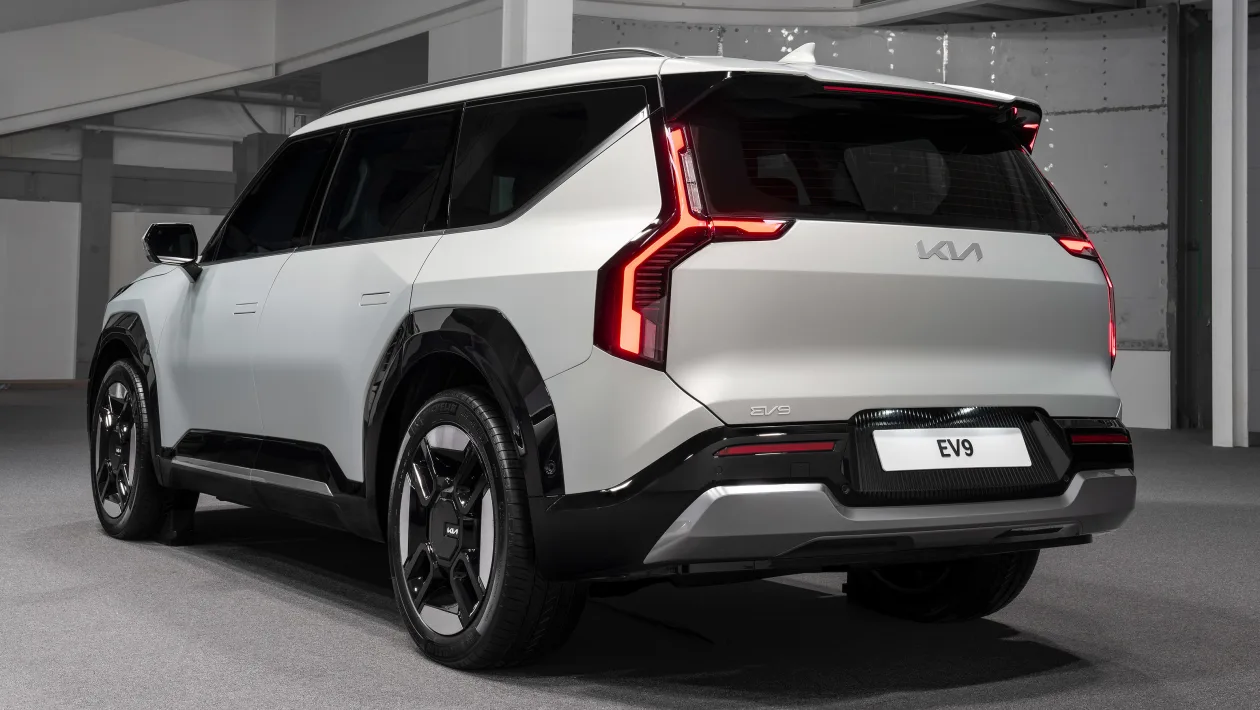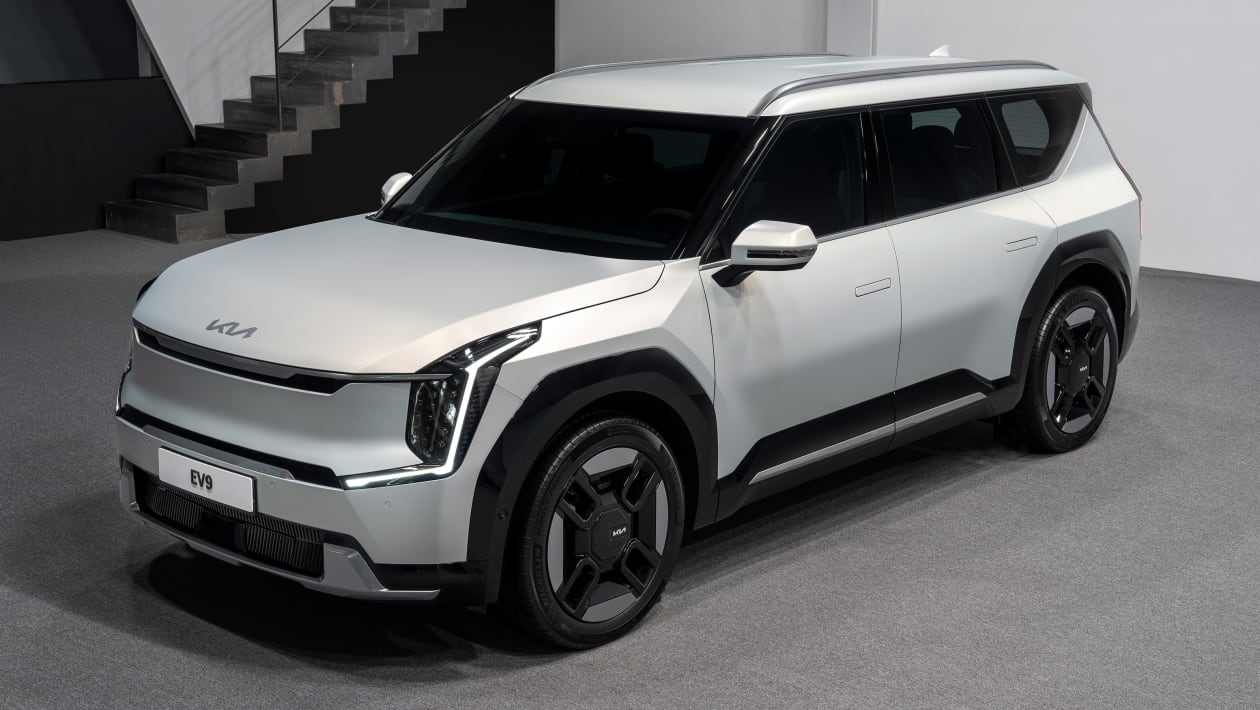Three versions of the Kia EV9 have been announced that include rear and all-wheel-drive and two battery sizes.
Further specs have been revealed for Kia’s EV9 electric SUV, following the flagship model’s reveal a couple of weeks ago. Details regarding battery capacity, range, power and charging technology have now been revealed.
At more than five metres long and almost two metres wide, the range-topping seven-seat EV will sit above the existing EV6 and forthcoming EV5 (above) in Kia model range. The most expensive versions of the EV9 will feature a large 99.8kWh battery, and its maker is targeting a maximum range of 541km on a charge for the very longest range version.
The EV9 will be offered with rear and dual-motor all-wheel-drive powertrains, all featuring the brand’s innovative 800-volt electric architecture built into the E-GMP platform shared with the EV6. That tech should ensure a 10-80 per cent charge in less than 20 minutes.
The base RWD car uses a 160kW/350Nm electric motor and will accelerate from 0-100km/h in 9.4 seconds, and is equipped with a 76.1kWh battery. The AWD variant, meanwhile, almost doubles the power output to 280kW/600Nm, slashing the benchmark sprint to six seconds flat. An optional boost function – available as an over-the-air (OTA) update – increases torque and reduces the 0-100km/h time to 5.3 secs. This version of the car comes with the 99.8kWh battery, while a third option exists in the form of a Long Range RWD car that combines a 150kW motor with the larger pack – this is the variant Kia claims a range of 541km for.
OTA updates are expected to feature prominently on the EV9; owners can visit the Kia Connect Store to purchase digital features and services on demand. The firm says this gives them the flexibility to choose features they want to “continuously upgrade the capability of the EV9”.
While exact Australian specifications are yet to be determined, the model line-up could mirror that of the EV6 hatchback. That should mean an entry-level RWD model, plus GT-Line RWD and AWD cars. Kia has also confirmed a high-performance EV9 GT model will arrive that will likely have over 430kW of power.
Equipment could include a trio of screens and at least 19-inch wheels, plus a leather-free cabin using “bio-based materials”, such as corn, sugar cane, and natural oils. Kia also says the EV9 will introduce “conditional” Level 3 autonomous tech.
Prices in Australia will be announced closer tot he EV9’s on-sale date, but are expected to start at around $90,000. Kia EV9 deliveries are expected to commence in the third quarter 2023.
The EV9 is designed to be the largest and most expensive zero-emissions vehicle in the Kia range. It’s one of 14 new EVs that the company will launch globally over the next five years, and is the first of nine that will make it into Australian showrooms.
The new creation is an overtly upright, blocky SUV that’s larger than the Sorento – more in line, in fact, with the five metre-long Telluride that Kia sells in the United States. That means it’s only very slightly shorter than the current Range Rover. It’s conceived as a seven-seater, although it will also be available in a six-seat layout, complete with two individual centre-row seats.
The car was previewed by a concept at the Los Angeles Auto Show back in 2021 and the production model sticks pretty closely to that vehicle’s lines.
The roof is a little lower, because the EV9 sits on slightly smaller 21-inch wheels, plus the concept’s rear-hinged back doors have been replaced by more conventional items, and there’s less ground clearance, courtesy of a proper floor that’s now thick enough to contain the battery pack. But the overall profile of the finished production car looks remarkably similar. The front features a fresh interpretation of Kia’s family grille, adapted for the greater height of this model compared with the EV6.
Kia’s designers say that the phrase ‘tiger face’ needs to replace the ‘tiger grille’ that featured on combustion-engined cars, since the EV9 doesn’t have a grille at all. There’s a framed body-coloured panel, and at either side of it, laser-etched areas of the body will allow patterns of LED light to filter through; users will be able to choose these designs through the infotainment system.
The daytime running lights at either side of the ‘tiger face’ are intricate vertical items inspired by star constellations, meanwhile; Kia calls them ‘star maps’ and says that they will be a feature on subsequent models.
The car’s bodywork includes a mixture of treatments. Some of the largest panels are extremely clean; the bonnet itself has no power dome like you’d find on a combustion-engined vehicle. But in line with Kia’s design philosophy of contrast, while the main flanks have only gentle curves, the adjoining shoulders are created by huge, brutal squared-off wheelarches, flared out through edgy triangular motifs. These give the car a strong, chunky look, almost like a Tonka toy.
Inside, there are warmer, more natural-looking materials than in the EV6, with fabric used in some key areas instead of textured plastics. The dashboard introduces a new design principle that will feature on Kia’s subsequent EV models; there’s just a single instrument and infotainment panel incorporating multiple displays, as on the EV6, but the contextual touch-sensitive buttons below have been replaced by a cleaner design with haptic feedback. Some of the more detailed functions of the heating and ventilation system have moved to the display, although the basics are taken care of by physical switches. There’s still a regular volume control, too.
Kia’s interior team, led by Jochen Passen, has worked hard on scalloping out areas of trim – around the arm rests, and on the upper edge of the fascia, to help create ‘negative space’ and make the cabin feel more spacious, open and relaxing.
The designers have also made use of the EV’s flat floor to create flexible storage solutions, including a small slide-out table between the front seats. In six-seat mode, the centre seats can be rotated to face backwards, although this may not be legal when the car is being driven, depending on local legislation.
When the seats are folded down, they create a flat surface to make it easy to slide in longer loads. There’s also a hard-plastic ‘frunk’ beneath the bonnet; it’s relatively modest in size, given the overall scale of the vehicle, but it should be large enough to accommodate a charging cable.
The company has already confirmed that as part of its ‘Plan S’ strategy, it will develop a high-performance EV9 GT, to sit above the 430kW EV6 GT in its portfolio.











